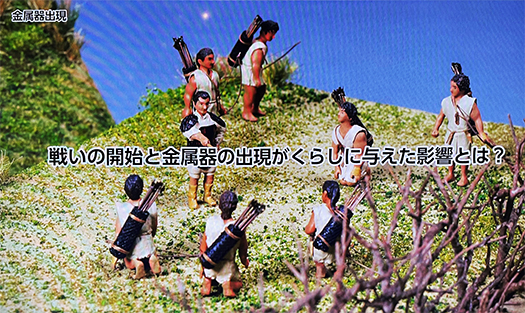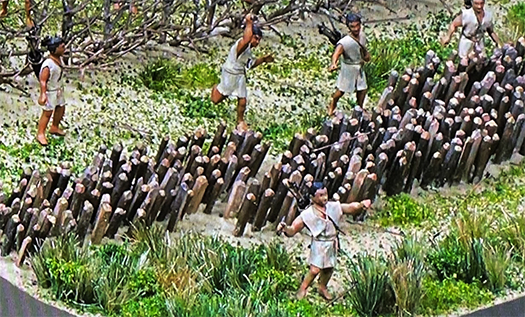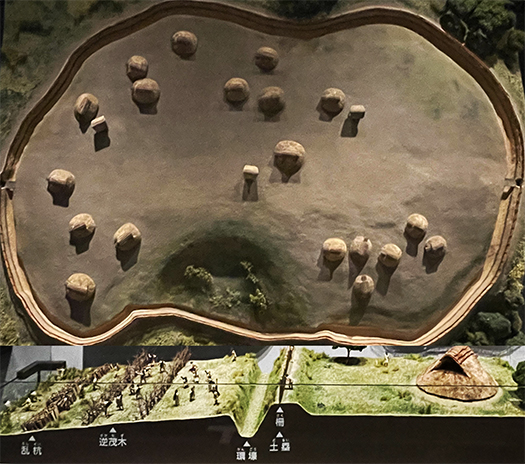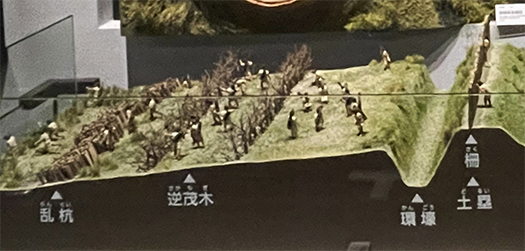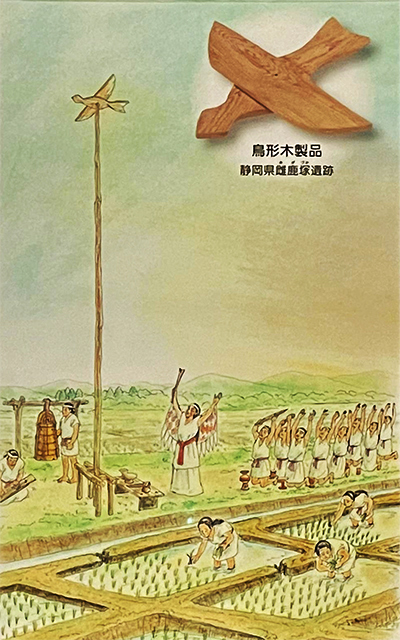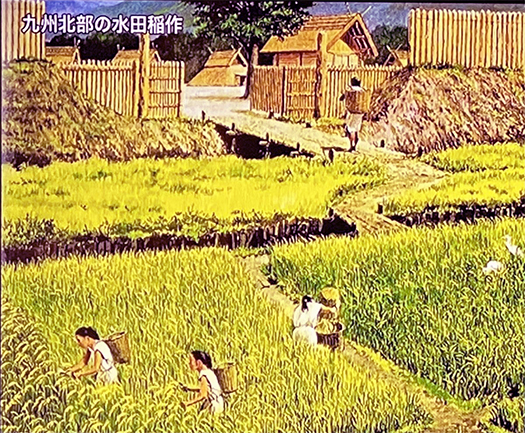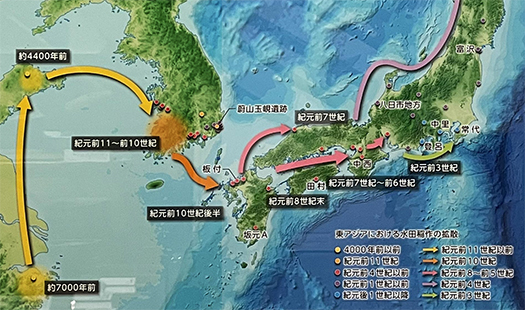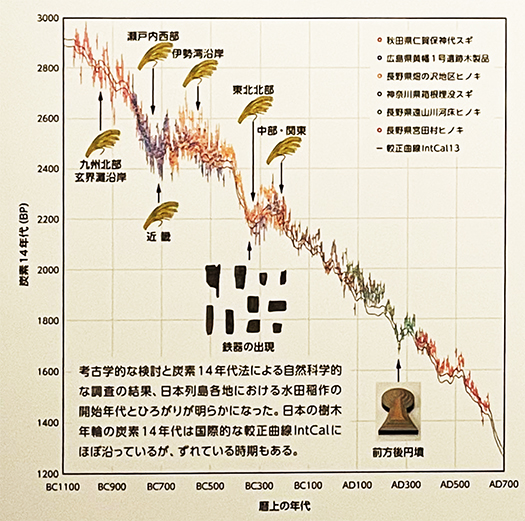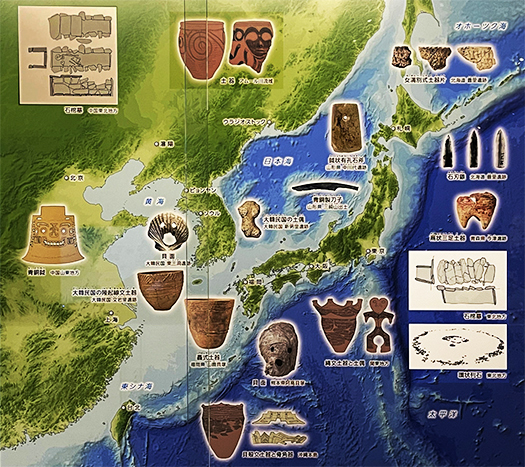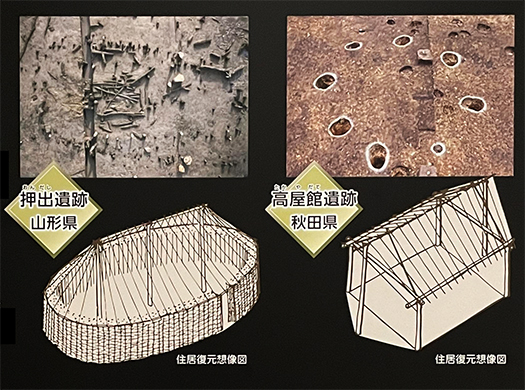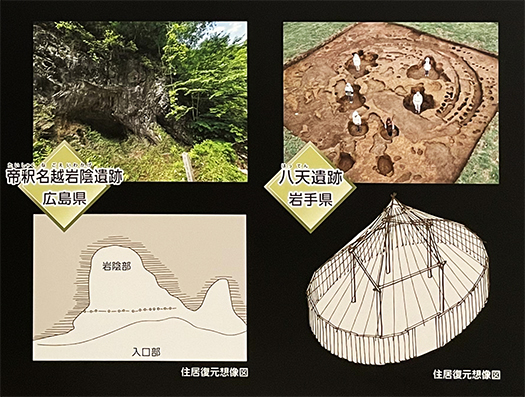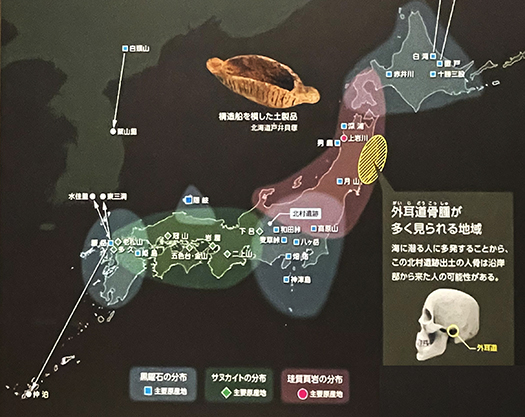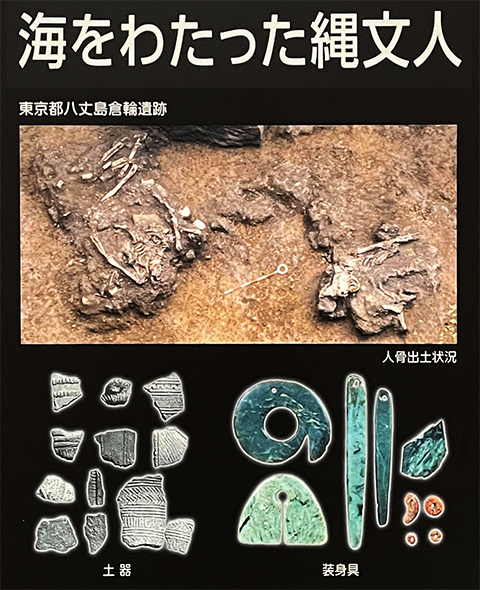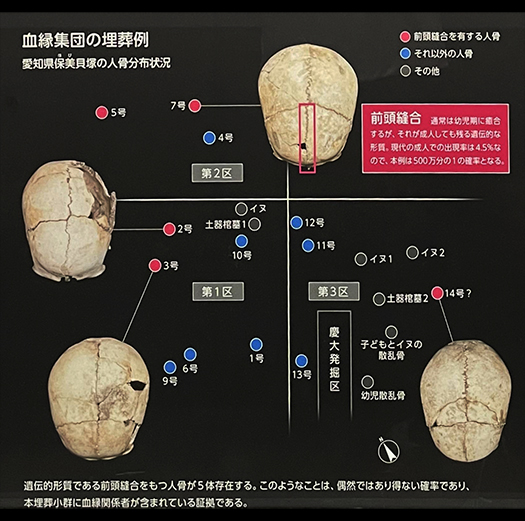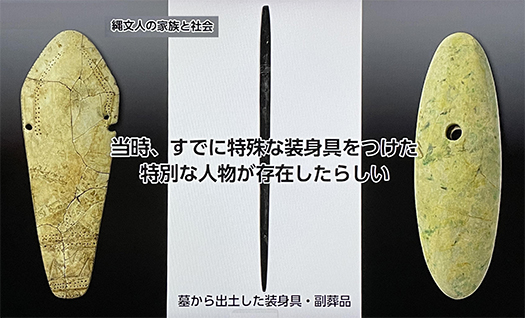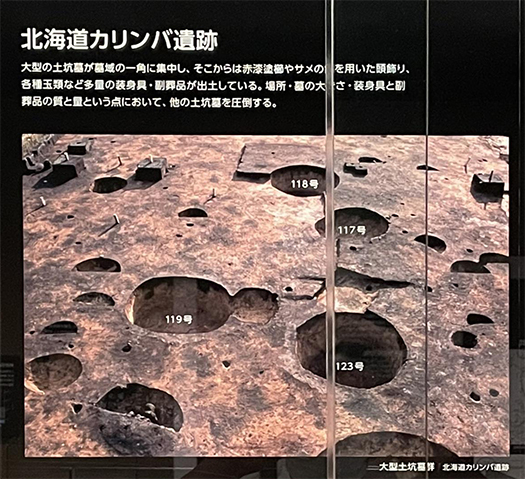
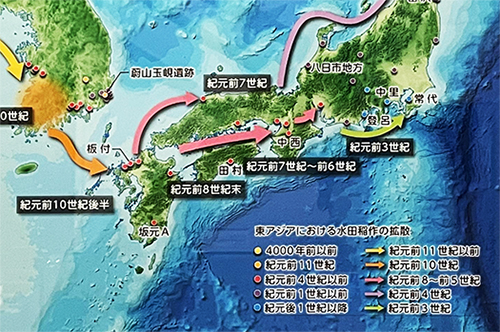
紀元前221年に中国大陸では「統一国家・秦」が成立し秦の始皇帝が出現した。
中国大陸では揚子江河口を中心とするコメ生産地域と黄河流域の小麦地域という
2つの基本的食糧生産システムが併存するけれど、
小麦と製粉技術が中国に伝来したのは漢代(紀元前202〜紀元後220年)。
前漢の武帝により西域に派遣された張騫の行路=シルクロード経由で
西方からもたらされた。唐代(618〜907年)になると、華北平原で
小麦栽培が盛んになり特権階級のものだった麺が北方民衆に普及したとされる。
・・・そうすると中国大陸でも「国家」という武力権力は
コメ生産システムの社会普及と並行してきたのだといえる。
秦による中国大陸の統一という事態は、当時の東アジア世界にとっては
相当のインパクトを持って波動していったことは容易に想像できる。
なんといっても日本列島は東アジア世界にとっては「ニューフロンティア」。
たしかに縄文のライフスタイルを固守する先住の人びとは存在したけれど、
九州北部地域から徐々に水田農耕が波及していった段階。
ちょうどアメリカ大陸にヨーロッパからの移住者が進出したのと似たことが
紀元前の時期に「弥生文化」として列島に波及したと思える。
人口規模を支える経済基盤としての優位性は縄文を凌駕していただろう。
この水田農耕地域の「東進」はようやく関東・房総へ到達した段階。
環日本海圏である津軽地域にはこれより以前、紀元前4世紀に到達。
そういうコメ文化受容段階で中国では統一国家が出現したことになる。
秦が統一を果たしてすぐに着手したのが「度量衡の統一」。
国家支配の基本原理が農耕社会の土地や収穫物の計量だったことは
その権力の基盤構造をあきらかにしてくれる。
こうした東アジア的な祭政の基本原理による強大な武力権力への
恐怖というものが容易に列島社会に伝わったことも想像に難くない。
大陸が小国家分立状態であるのと、統一国家であるのとでは
「脅威」の度合いがはるかに違うだろう。
コメ文化によって画一的なライフスタイル、文化圏が作られていくほどに
大陸との国際関係論という意識構造が列島社会で支配的になったことも
これは必然的な成り行きだったことだろう。
この時代以降、神武東征によって古代王権が姿を現す段階まで
国際的な緊張関係として列島社会に迫られていた政治要素だったといえる。
いわゆる「日本史」という事象が徐々に成立していくことになる。・・・

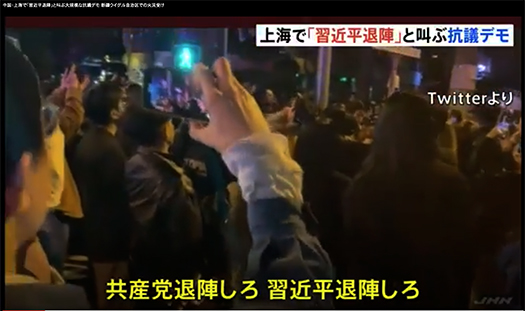
こうした東アジア圏地域での歴史的な「波動」は現代にも
まったく同様に生起し、いわば運命的な「共存関係」が存在している。
海洋国家として世界に開く方向をいち早く選択した日本社会は
幾多の歴史困難を超えて自由社会の価値感を世界と共有しているけれど、
巨大人口の中国社会では現代も困難な局面を迎えている。
あまりにも巨大すぎることが、政治のありようを困難にするのだろうけれど、
独裁が歴史的に一般的な大陸国家で、あからさまな独裁者批判が
朝の雄鶏の叫び声のようにこだましはじめている。
大陸国家での易姓革命ごとの東アジア世界危機も経験してきた日本人として
自然に鋭敏にならざるを得ない。さてどうなっていくのか?
English version⬇
37,000-Year History of the Japanese Archipelago in East Asia since the Establishment of the Qin Dynasty in China – 29
The dictatorship of the “emperor” emerged during the period of acceptance of the rice production system. The long-lasting coexistence in the East Asian world. …
In 221 B.C., the “unified state of Qin” was established on the Chinese continent and Qin Shi Huangdi, the first emperor of China, emerged.
In mainland China, two basic food production systems coexist: the rice production area centered at the mouth of the Yangtze River and the wheat production area in the Yellow River valley.
Two basic food production systems coexist on the Chinese mainland: rice production centered at the mouth of the Yangtze River, and wheat production in the Yellow River valley.
Wheat and milling technology were introduced to China during the Han Dynasty (202 B.C. to 220 A.D.).
It was brought to China from the West via the Silk Road by Zhang An, who was dispatched to the West by Emperor Wu of the previous Han Dynasty.
Zhang Xian was dispatched to the West by Emperor Wu of the Han Dynasty. In the Tang dynasty (618-907 A.D.), wheat cultivation flourished in the North China Plain
Wheat cultivation flourished in the Tang Dynasty (618-907) in the North China Plain, and noodles, which were once the preserve of the privileged class, are said to have spread to the people of the north.
In this way, the armed power of the “state” in mainland China was also
This suggests that the military power of the “state” in mainland China was concurrent with the spread of the rice production system in the society.
The unification of the Chinese continent by the Qin Dynasty had a considerable impact on the East Asian world at that time.
It is easy to imagine that the unification of the Chinese continent by the Qin Dynasty had a considerable impact on the East Asian world at that time.
After all, the Japanese archipelago was the “new frontier” for East Asia.
While it is true that there were indigenous peoples who adhered to the Jomon lifestyle, there was also a gradual shift to paddy field agriculture from the northern Kyushu region.
However, the Jomon lifestyle was not yet fully realized in Japan until the paddy field agriculture gradually spread from the northern Kyushu region.
This is similar to the arrival of European immigrants in the Americas.
The Yayoi culture, similar to the European immigration to the Americas, spread to the archipelago in the prehistoric period.
The Yayoi culture would have surpassed the Jomon in terms of its superiority as an economic base to support the size of the population.
This “eastward expansion” of rice paddy farming areas finally reached the Kanto and Boso regions.
The Tsugaru region, which is part of the Japan Sea Rim, was reached earlier, in the 4th century BC.
It was at this stage of rice culture acceptance that a unified state emerged in China.
As soon as the Qin Dynasty achieved unification, it immediately set about “unifying the balance of weights and measures.
The fact that the basic principle of state rule was the weighing of land and harvests in an agrarian society
The fact that the basic principle of state rule was the measurement of land and harvests in an agrarian society reveals the foundational structure of power.
The fear of a strong military power based on such a basic principle of East Asian rituals is easily transmitted to the societies of the archipelago.
It is not difficult to imagine that the fear of powerful military power based on these basic principles of East Asian rituals could be easily transmitted to the island societies.
The degree of “threat” would be much different if the continent were a unified nation than if it were a divided state of small states.
The degree of “threat” would be far different.
The more uniform lifestyles and cultural spheres are created by rice culture
The more uniform lifestyles and cultural spheres were created by the rice culture, the more the structure of consciousness of international relations with the continent became dominant in the archipelago society.
This was an inevitable consequence.
From this period onward, until the ancient royal power emerged through the Jinmu expedition
This was a political element of international tension that was pressing on the society of the archipelago.
The so-called “history of Japan” was gradually established. …
These historical “waves” in the East Asian region
The same historical “waves” in the East Asian region are occurring in the present day, and a fateful “coexistence” exists, so to speak.
Japanese society, which was one of the first to choose to open itself to the world as a maritime nation, shares the values of a free society with the rest of the world.
Japanese society, which chose to open itself to the world as a maritime nation, has overcome many historical difficulties and shares the values of a free society with the rest of the world.
However, the Chinese society, with its huge population, is facing a difficult phase even in the present age.
The sheer size of the population may make politics difficult, but it also makes it more difficult to maintain a free society.
In a continental nation where dictatorships have historically been the norm, overt criticism of dictatorships is
The overt criticism of dictatorships in continental countries, where dictatorships have historically been common, is beginning to echo like the crowing of a morning rooster.
As Japanese who have experienced the East Asian world crisis that followed the Yi Surname Revolution in the continental world
I am naturally sensitive to the situation. What will happen now?
Posted on 11月 29th, 2022 by 三木 奎吾
Filed under: 日本社会・文化研究, 歴史探訪 | No Comments »


